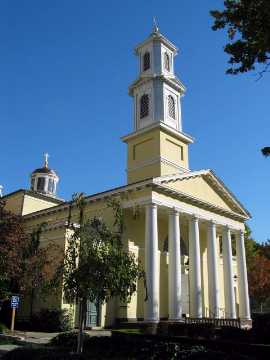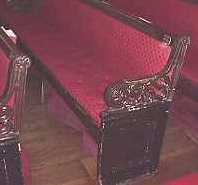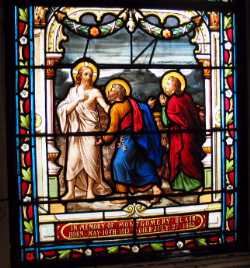Home | News | Books | Speeches | Places | Resources | Education | Timelines | Index | Search
© Abraham Lincoln OnlineSt. John's Episcopal Church
Lafayette Square, Washington, D.C.When President Abraham Lincoln took office in 1861, St. John's Episcopal Church was well established as "the church of the presidents," thanks to its downtown Washington location and ability to attract famous, influential members. Benjamin Latrobe, the original architect, also designed the White House porticos and worked on the U.S. Capitol. In 1815 he designed the church using a Greek cross plan with equal arms and a cupola. By the time Lincoln arrived, later architects had modified the structure into a Roman cross and added a portico and bell tower. The bell which Lincoln heard was cast by Paul Revere's son in 1822 and still hangs in the gold-domed tower.
The stuccoed brick church remains an historic jewel on Lafayette Square. Located two blocks north of the White House, its doors opened to worship services in October 1816. In December the church vestry offered a free pew to President James Madison, who insisted on paying the annual rent himself. Early parishioners primarily supported the church by purchasing pews and paying rent for them. When Madison chose pew no. 28 (since renumbered 54) he unwittingly started a tradition followed by every American president since -- to worship there regularly or occasionally. Presidential visits already were considered obligatory by Lincoln's time.
President-elect Lincoln first attended services on Sunday, February 24, 1861, the day after arriving in Washington. His wife and sons chose to attend services elsewhere with a family friend. Lincoln accompanied William Seward, his future secretary of state, who steered him into his own pew (no. 1) near the altar, rather than the customary presidential pew. Seward's pew was removed in 1968 to make room for a small chapel. Several years later a visitor tracked it down in the church crawl space, where it had been broken apart.
A contemporary newspaper article revealed that few people in the congregation noticed Seward's visitor or recognized him. The reporter wrote, "Mr. Lincoln was dressed in plain black clothes, with black whiskers and hair well trimmed, and was pronounced by such as recognized him as a different man entirely from the hard-looking pictorial representations seen of him. Some of the ladies say he is almost good looking."
The Presidents' Pew
© Abraham Lincoln OnlinePresident Lincoln eventually used the presidential pew in morning services, according to Jane Wilkes, who sat three rows behind it. The Wilkes family, members since 1844, donated one of the altar windows. Jane noted that Lincoln would attend with his White House secretary, John Nicolay and assistant John Hay. Jane's father was Admiral Charles Wilkes, who precipitated an international incident in late 1861. As captain of the U.S.S. San Jacinto, he captured the British mail packet Trent in international waters and removed Confederate envoys James Mason and John Slidell. Although hailed by the public, the action brought U.S.-British relations to a crisis, which was resolved after some diplomatic maneuvering and release of the prisoners.
President Lincoln did not join St. John's but instead rented a pew for his family at the nearby New York Avenue Presbyterian Church. However, he sometimes attended other services, using a pew in the last row, southwest side (no. 89). The Rev. George Williamson Smith, who served St. John's in 1863-64, recalled seeing Lincoln slip into this pew at evensong or the evening service. Always alone, he left just before the service ended, unnoticed by others in the congregation.
This habit mirrored one which Lincoln developed at the New York Avenue church. There he would listen to the midweek evening prayer service from the pastor's study adjacent to the lecture room to avoid attention. Given the immense pressure he endured in his administration and the constant stream of visitors to the White House, it is little wonder that he sought a quiet refuge.
During most of Lincoln's presidency the rector at St. John's was Dr. Smith Pyne, who assumed the position in 1845. Although this Oxford-educated minister grew up in Charleston, South Carolina, he proved staunchly loyal to the Union cause. His son Charles joined the Union Army in 1861 and was wounded at the Second Battle of Bull Run. The Lincoln administration called on Dr. Pyne to conduct the White House funeral of Colonel Elmer Ellsworth on May 25, 1861. He also offered the prayer at a flag-raising ceremony on the White House south lawn on June 29, 1861. In 1864 Dr. Pyne petitioned Lincoln on behalf of Admiral Wilkes, who had been court-martialed and suspended from the Navy, writing, "I have long felt myself bound to you both in your official and personal character." Whether in response to this plea or from his friend Orville Browning, who represented Wilkes, Lincoln reduced the suspension several months later.
Montgomery Blair Window
© Abraham Lincoln OnlineBesides William Seward and Winfield Scott, St. John's was the church home of many Lincoln contemporaries such as Montgomery Meigs, Salmon Chase, Gideon Welles, Gustavus Fox, John Worden, George Bancroft, and members of the Blair family. In addition to stained glass windows dedicated to Seward and Scott, you will find this memorial window for Montgomery Blair, Lincoln's first Postmaster General. It depicts Jesus with Peter and John and was designed by the Lorin studios of Chartes, France. The church's stained glass windows were added after Lincoln's death. Visiting Information
You will find St. John's Church at the corner of 16th and H Streets, (1525 H Street) on the north side of Lafayette Square. Guided tours of the building are available most Sundays after the 11:00 a.m. service. For special tours, call the church office at 202/347-8766. The nearest Metrorail stops are McPherson Square and Farragut North.
Related Reading
Green, Constance M. The Church on Lafayette Square. Potomac Books, 1970.
Grimmett, Richard F. St. John's Church, Lafayette Square: The History and Heritage of the Church of the Presidents, Washington, DC. Hillcrest Publishing, 2009.
Washington Evening Star, February 25, 1861.
Zinsmeister, Robert Jr. "The Forgotten Pew," Lincoln Herald, Summer 1975, pp. 114-120.
Related Sites
Lincoln in Washington Blog/Map
Webcast: Richard Grimmett on "The History and Heritage of the Church of the Presidents" (LOC)
Home | News | Education | Timelines | Places | Resources | Books | Speeches | Index | Search Text and photos copyright © 2017 Abraham Lincoln Online. All rights reserved. Privacy Policy



